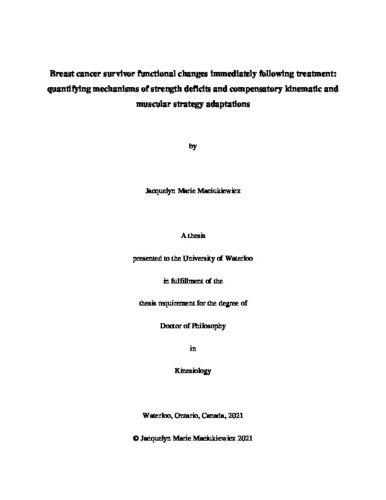| dc.description.abstract | Breast cancer is prevalent among Canadian women, but treatments may cause functional impairments among survivors. Over 22,000 Canadian women join the survivor population yearly (Brenner et al., 2020). Despite this substantial number, minimal research has approached the challenges faced by this population after primary treatment. Particularly, decreases in strength, range of motion and shoulder-related quality of life are widely reported (Harrington, Padua, Battaglini, & Michener, 2013; Lee, Kilbreath, Refshauge, Herbert, & Beith, 2008; Rietman et al., 2004). These factors, linked with changes in kinematics and muscular activation may result in further complications (Brookham, Cudlip, & Dickerson, 2018a, 2018b). Variability in previous studies, in both the population sampled and results make it difficult to isolate potential mechanism disrupting function. Further, this complicates the determination of key deficits to target in the early years of survivorship. Therefore, the purpose of this dissertation was to determine which factors affect breast cancer survivors in the first two years following the conclusion of treatment, if these factors translate to differences during low load functional tasks, and to investigate the feasibility of increasing strength (as a surrogate for function) to help mitigate these factors and increase function.
Study 1 and 2 shared an in vivo experimental collection, with Study 3 using input from the collection in an in-silico approach. Briefly, 35 breast cancer survivors within two years since the conclusion of their treatment participated in the experiment. Participants completed a general questionnaire about their diagnosis, three shoulder-related quality of life questionnaires, and a Godin-Shephard leisure-time physical activity questionnaire, followed by a dual energy x-ray absorptiometry (DXA) scan. Eight muscles were monitored on the affected limb (pectoralis major (sternal and clavicular), deltoids (anterior, middle and posterior), infraspinatus, supraspinatus, and latissimus dorsi). Six maximal isometric strength trials were completed (flexion, extension, abduction, adduction, internal rotation and external rotation). Kinematics of the affected limb were collected for the remaining trials. These consisted of 6 maximal range of motion trials (flexion, extension, abduction, scapular abduction, internal rotation and external rotation), as well as 8 activities of daily living.
Study 1 clustered participants into two distinct groups, the low score cluster (LSC) and high score cluster (HSC). The variance in treatment, force production, range of motion, body composition and shoulder-related quality of life is well documented in literature, however there is no distinguishing characteristics that separate survivors who may need rehabilitation following treatment. This study determined, through feature reduction, that internal rotation force production, active extension range of motion and 3 shoulder related quality of life variables (energy/fatigue, social functioning and pain) separated survivors within 2 years of treatment into two clusters (LSC and HSC). The LSC participants had higher self-reported disability, role limitations (health and emotion), fatigue, and lower self reported physical well-being, along with lower abduction, adduction, extension and flexion force production (p<0.001). Several other factors differed between groups (p<0.05); the HSC group had more lean mass of the affected arm, internal and external force production and active flexion range of motion. These factors highlight potentially important factors to address in a rehabilitation program, as survivors finish treatment, specifically that lower force production likely corresponds to lower self-reported shoulder-related quality of life.
Study 2 contrasted the muscular activation and kinematics of the LSC and HSC during various activities of daily living. The selected low load functional tasks can indicate survivors’ ability to complete daily tasks and return to work. The LSC used lower range of angles, and increased muscular activation. Range of angles differed 6.5-16.1° across elevation angle, axial rotation and plane of elevation during the shelf reach, forward reach, pitcher pour and tray transfer tasks. Additionally, the LSC had 0.89-12.73% MVC more muscular activation than the HSC across all muscles and tasks. At least one muscle differed between groups during each of the 8 tasks investigated.
Finally, study 3 simulated various treatment scenarios to find a maximal producible force and the internal muscle forces required to produce that force in a compromised system with an in-silico approach. Beginning with the force from the LSC, and increasing capacity of muscles based on given treatment scenarios (permanent damage of a subset of muscles from radiation, or overall reduction in capacity due to chemotherapy, or a combination of both), 70-80% of strength in adduction and internal rotation is recoverable if retraining of muscles can be achieved. Specifically, for adduction rhomboid (major and minor), upper trapezius, subscapularis (lower), and triceps (long), latissimus dorsi (upper and lower), pectoralis minor, middle deltoid, middle trapezius and biceps (short) increased during the various simulations to increase force output compared to the LSC group. During internal rotation, latissimus dorsi, rhomboid (major and minor), upper trapezius, posterior deltoid, subscapularis (middle and lower), triceps (long), pectoralis minor, middle deltoid, and middle trapezius estimation increased from the LSC group levels in each of the simulations. Although no scenario reached reference control population force levels, achieving 70-80% of force would be meaningful for enabling daily task performance, returning to work and enhancing physical self-efficacy.
Taken together, these studies point towards novel strategies and valuable considerations in creating rehabilitation foci that enable improved arm function for breast cancer survivors. | en |

